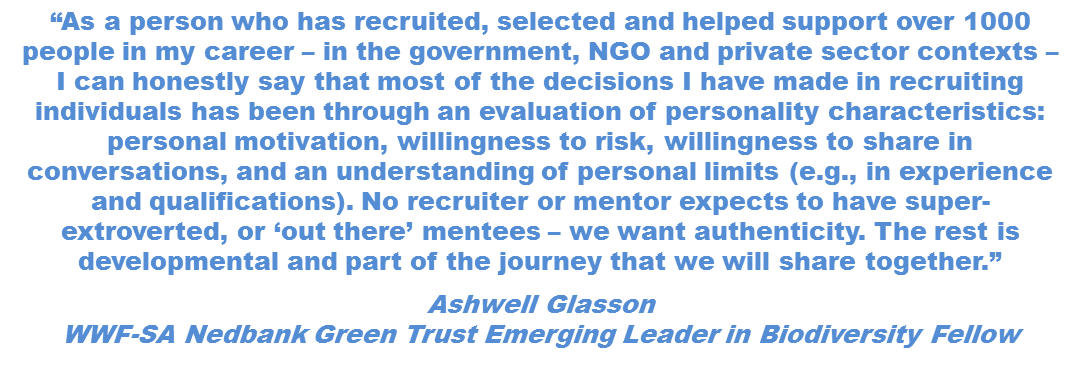Early-career blog series: Finding meaningful work in the environment and development sectors

Many of us choose to work in the environment and development sectors because we care deeply about human or animal wellbeing, sustainability, equity, and conservation. Although we are full of passion for our work, developing a career in these sectors can be challenging because there is not always an obvious career trajectory to follow.
So, how should you navigate through this confusing terrain in your early professional life? In this 5-part blog series we’re going to help you to develop a vision for your career, and arm with you some skills that can help you reach your career goals. Each post has been co-written by professionals that have gone through their own career journeys within the environmental sector.
In this post we are joined by Ashwell Glasson (environmental training and development specialist) and Bentley Kaplan (climate change and environmental consultant).
Blog Post 1
CREATING A VISION FOR YOUR CAREER
By Zoë Visser, Tali Hoffman, Bentley Kaplan and Ashwell Glasson
With your particular set of qualifications and experience, it is likely that there are various career paths that you could pursue within the environment and development sectors. As you plot your path it is helpful to have a flexible career vision that can guide your decision-making. A career vision can be especially helpful in the first five years of your working life, when you are still discovering where you fit in and where your passion lies.
Here are some basic steps to follow to develop a vision for your career:
1. Where do I (and don’t I) fit into things?
Use online resources – like those developed by GreenMatter and Prospects – to help understand how your particular skills and experience relate to the broad job categories associated with different postgraduate qualifications. Start with working out where – more or less – you could fit into the sector that most interests you.
Consider your skills as well as your qualifications when you’re trying to determine which sector you should look for work in.

2. Where do I want to go?
Take time to think deeply about what is really going to work for you in your future career.

Then write down some of the themes that you are most passionate about. Are you a specialist who is interested in a very particular topic, or are you more generally interested in a field of work or a cause?
Based on these insights, write a short vision statement for your career. You could also draw a career mind map that can unpack some of those themes and help you to prioritise or align them to your personal vision statement. (Bear in mind that this career vision can, and most likely will, change over time as you continue to develop your ideas of what a successful career looks like to you).
3. Do I really want to go this way?
Test your assumptions about a particular career path. Speak to people who are further down a similar career track (watch out for one of our coming blogs about how to network with people – even the ones that scare you). Even very busy people may be receptive if you politely ask them for half an hour of their time.
Treat these career-conversations as opportunities to evolve your thinking. Do your research and arrive prepared to ask intelligent questions about what each person’s work involves, what they enjoy most about it, how they started doing it, and what they find most challenging. Don’t be shy in these meetings! Your personality, your insights and how you engage with the conversation is what will be most memorable.

Get an idea of the salary scales associated with different job levels in your chosen career path. Some work might pay poorly in junior positions, but become more lucrative in senior positions. Be honest with yourself about how much money you would like to, or need to earn.
Are you willing to travel? Travelling is a bigger part of some jobs than others, so make sure that you understand the likely travel requirements of the careers that interest you most. Also consider whether you are open to working in different cities or countries to gain experience that could broaden your horizons and bolster your skillset.
With all these things in mind, think about the tradeoffs that you are – and aren’t – willing to make. Consider whether you are willing to, for example: i) do work that you love but pays relatively poorly; ii) spend time away from your family; iii) relocate for work or; iv) work in a highâpressure environment. Having said that, sometimes, these tradeoffs only emerge once you’re working in a job, but they’re always worth thinking about.
4. Are there any gaps in my skillset?
Once you have a career vision, conduct a gap analysis of your skills and qualifications. Are there any postgraduate qualifications that you need to obtain to pursue this particular career path? Are there any industry-related (e.g., ISO auditing) or occupational short courses (e.g., project management) that could boost your knowledge and skills in new and relevant ways? Can some of your missing skills be obtained through work experience?
One way of doing a gap-analysis is to look at the advertised job descriptions for various job types and position levels (e.g., entry-level, mid-level and senior). Roughly compare how you align to these descriptions with your current skillset, and then determine what other skills you could acquire in future to align to the careers that most interest you. For example, you might need a PhD for Career X, but not for Career Y. So, if you are interested in Career Y, your time might be better spent gaining practical experience in your field rather than working towards a PhD.
5. Keep an eye on how the sector is evolving.
Position yourself to make the most of emerging opportunities by continually reflecting on your career vision in light of what is happening in the sector.

You might have to revise your career vision throughout your work life. In fact, very few people have linear careers, and there may be many twists and turns in your journey. Building character and life experience may just be a happy side-effect of building your career.


WHAT’S UP NEXT…
Once you’ve spent enough time in your armchair or beanbag thinking about how to develop your career, it’s time for action. But what kind of action? Is it worth sliding your CV under the windscreen wipers of CEOs parked cars? Do you storm the stage at the next TEDx event with your LinkedIn profile printed on your T-shirt? Relax, we’ve got your back – join us in our next blog for some smart, savvy steps on how best to ignite your career.
Disclaimer: The views expressed here are solely those of the authors in their private capacity and do not in any way represent the views of the ACDI, or any other entity affiliated with the ACDI.